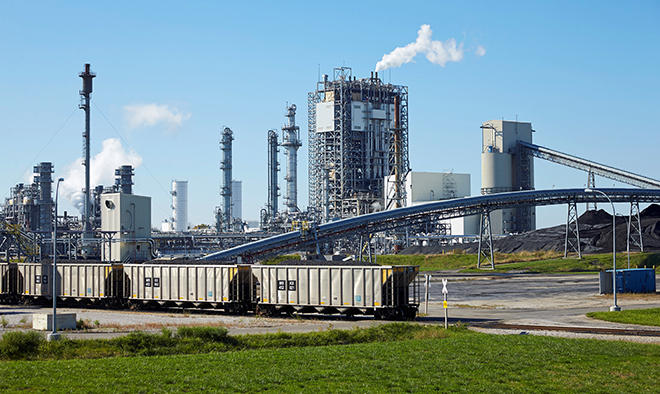
| Duke Energy Indiana's 618-MW Edwardsport coal gasification power plant could be retired by 2035 or outfitted with carbon capture technologies as part of Duke Energy's clean energy transition plans. Source: Duke Energy Corp. |
As Duke Energy Corp. prepares for a major pivot away from coal-fired generation, the company will spend about $52 billion of its new five-year capital plan on zero-carbon generation and grid modernization.
The planned investments are part of a $63 billion capital plan for 2022 through 2026 announced Feb. 10 ahead of Duke Energy's fourth-quarter 2021 earnings call.
"As we look ahead to what we can accomplish in 2022 and beyond, we feel like we've built a really strong foundation that we can build on," Duke Energy Chair, President and CEO Lynn Good said in a Feb. 10 phone interview. "We've got $63 billion of potential investment over the next five years, 80% of which will be directed toward the clean energy transition. And we have the potential for that $63 [billion] to grow to $130 billion over the decade."
The CEO said the "solid runway of investment" will drive 5% to 7% adjusted earnings growth through 2026 and help meet its carbon reduction targets.
 Duke Energy Chair, President and CEO Lynn Good Source: Duke Energy Corp. |
On Feb. 9, Duke Energy announced plans to cut coal to less than 5% of its total generation by 2030 and "fully exit coal by 2035."
Duke Energy owns about 16 GW of coal-fired generating capacity, making up a little more than a quarter of its overall owned portfolio, according to S&P Global Market Intelligence data.
Duke Energy also expanded its 2050 net-zero goals to include Scope 2 and certain Scope 3 emissions. In addition, the company added a new net-zero by 2050 goal for its natural gas business that includes upstream methane and carbon emissions related to purchased gas and downstream carbon emissions from customer consumption.
To reach its goals, Good said the company will rely on a "diverse mix of resources" including renewables, battery storage, nuclear generation and "some natural gas as needed for reliability."
"As we get deeper into this decade, we'll begin to look at other clean technologies" including offshore wind, hydrogen and advanced nuclear resources, the CEO said.
Future technologies
Duke Energy's five-year capital plan does earmark about $4 billion for hydrogen-enabled natural gas generation, but Good noted that the bulk of the company's carbon-reduction planning this decade is focused on existing technologies.
The Charlotte, N.C.-headquartered investor-owned utility plans to increase its renewables portfolio to 16,000 MW by 2025 and 24,000 MW by 2030. "There is also a lot of storage investment going on in the 2020s," Good said.
The CEO underscored the need for natural gas generation during its fleet transition.
"We believe some natural gas could be important in the 2020s as we retire this coal and maintain reliability and dispatchability to fit with all of these renewable resources," Good said. "But as we think about natural gas, we're also working on things like hydrogen, renewable natural gas [and] advocating for the work that is going on in the [National Carbon Capture Center], so we know that that infrastructure will be useful over the next couple of decades."
Duke Energy's clean energy transition contemplates retiring Duke Energy Indiana LLC's 618-MW Edwardsport integrated gasification combined-cycle power plant by 2035 or adding carbon capture utilization and storage to the coal gasifiers.
"I would think about those new technologies as being more important in the 2030s and 2040s," Good said. "I would add advanced nuclear to the mix, small modular nuclear to the mix, so that you have the characteristics that come from natural gas in the form of either hydrogen-enabled carbon capture or an advanced nuclear product that has storage capability. So, what we're really looking for are things that operate like a natural gas plant in the system."

M&A
While other U.S. utilities and power providers have offloaded assets and regulated businesses over the past 12 months to help reduce fossil fuel exposure, Good indicated Duke Energy does not have similar plans in the near term.
"We regard everything we own today as core to Duke," Good said. "if you look back over the last 10 years, we've made a lot of portfolio adjustments, selling and adding, to get to the place we are today. We're 95% regulated. We operate in very constructive jurisdictions with an ability to deploy capital toward this clean energy transition and deliver returns for our investors."
Early in 2021, Duke Energy announced the sale of a nearly 20% interest in utility subsidiary Duke Energy Indiana in a move that allowed the company to avoid raising $1 billion in common equity. The proceeds from the two-phase transaction are expected to help fund Duke Energy's capital plan and satisfy all capital raising needs through 2025.
"The transaction we entered into in January of 2021 was a very innovative way to raise capital and we were able to do so at a price that was more competitive than outright issuing Duke equity," Good said. "We would consider transactions like that if we find ourselves in the need for equity in the future as this energy transition continues. But I believe our organic growth story is so compelling that is where our focus and strategic attention is at this point."



